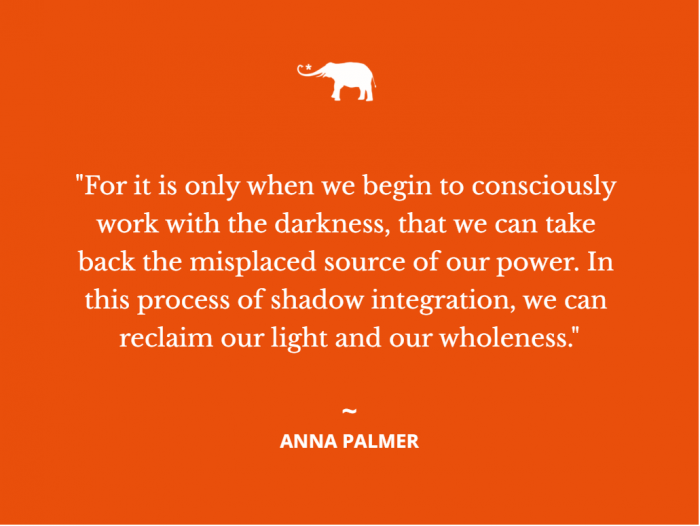The following article is an excerpt from Anna Palmer’s book, Coming Home: Healing From an Eating Disorder by Finding Beauty in Imperfection. May the words here grant you deeper permission to come home to the fullness of yourself, humanness, divinity, and all. Welcome home.
~
Chapter 10. You’re Telling Me I Have A Shadow? Shadow Work, Shamanism, Dreams, and the Un-integrated Ego
“Everyone carries a shadow, and the less it is embodied in the individual’s conscious life, the blacker and denser it is. At all counts, it forms an unconscious snag, thwarting our most well-meant intentions.” ~ Carl Jung
As a child, I was afraid of the dark. I would hide under the covers at night in order to feel safe. When we went camping as a family, I remember many times waking up in utter terror of the pitch-blackness of our camper trailer. I would scramble in a panic for a source of light. My eyes couldn’t see anything but darkness, and I had no orientation of where I was.
Throughout my childhood, these disorienting night terrors would happen occasionally. In my day-to-day waking reality, I feared being in small or dark spaces. I would cry in terror on one particular water park ride that weaved through a long, dark tunnel. I remember panicking and crying when my grade school class took a field trip to a cave and the tour guide turned off all the lights. Darkness was something I feared greatly.
The darkness. The shadow. The darkness encompasses the unseen aspects of life. The feminine. The Mystery. The Unknown. The dark side of the new moon. It is the emotional undercurrent. The subconscious.
As much as it is feared, the shadow is innately woven into the fabric of consciousness. We can’t have light without the shadow. I feared the shadow and darkness for most of my life. I believed it was something to be avoided, abolished, or denied.
My childhood fear of the dark acted as a metaphor for my fears of facing the internal darkness and witnessing the darkness of the external world. I wandered in the darkness of bulimia for many years desperately hoping someone else would turn on the light for me. I didn’t know that light had to come from me.
For it is only when we begin to consciously work with the darkness, that we can take back the misplaced source of our power. In this process of shadow integration, we can reclaim our light and our wholeness.
Carl Jung, a prominent early 20th century psychotherapist and psychiatrist of his time and beyond, first introduced the concept of the “Shadow.” He would do groundbreaking work in the realms of the conscious and subconscious mind. His work focused on dream work, charting human and collective archetypes, and delving into the human psyche and healing realms of mysticism and psychology. Today, his legacy and teachings continue into modern day psychology and spirituality.
The Shadow, in short, is the subconscious mind and the hidden side of our nature. It is the side of us that we don’t always consciously see or acknowledge. It holds the oftentimes repressed, darkened layers of our human experience. The Shadow is anything we have hidden from ourselves, often the less accepted traits and characteristics of being human.
The pain and shame we experience as a young child is carried with us into adulthood, if not dealt with at the time of injury. Through traumatic experiences, especially, we learn what parts of our nature are more acceptable than other parts. We learn that love is conditional, and can be taken away at any moment, when we are not “performing” correctly, or when we are behaving “badly.”
We learn from our parents and society which traits are deemed loveable and which traits are not. We hide the less than admirable traits in the Shadow. The Shadow (comprised of the Unconscious Mind) has a power that drives most of our behaviors.
The traits deemed unlovable, such as selfishness, having needs and desires even, greed, anger, fear, and sadness all comprise the Shadow. The Shadow is an archetypal energy that Jung coined to describe anything outside the realm of our awareness, hidden rather, in the subconscious mind, or the body (as ancient yogis believed).
Everyone has a Shadow. If you are a human on this planet, you have a Shadow. Some people are more aware of theirs and may have a more integrated one than others. Some are in a space of denial of their shadow parts, which in and of itself is a dangerous game to play.
“In these ways, the personal shadow reinforces, encourages, and becomes dependent upon the addictive behavior to express itself, to have any existence in the light outside of the closet, the attic, and the basement where it has been locked up and hidden for so long. Often the addictive behavior allows the personal shadow the only opportunities to live and to be. The more cut off and unconscious we are of our personal shadows, the more vulnerable we are to having those shadows break out and be set free for a time by addictive behaviors.” (War of the Gods in Addiction, David Schoen).
Without awareness and integration of our Shadow, addiction can become a means to express our Shadow aspects in an attempt for the Shadow to be seen by the individual’s consciousness. An addiction is the Shadow’s way of telling the conscious mind, “Pay attention to me!” First, we must pay attention and acknowledge these darker, wounded parts of ourselves. In doing so, we can begin the quest of reclaiming our innate wholeness, of integrating both our Shadow and our Light.
Looking through a spirituality lens at life, we are both light and dark. We are demon and God/dess. From this perspective, we are no longer seeking just the Light, but our wholeness. And to become whole means to embrace and integrate the Shadow.
Much of the time, religion disregards the Shadow’s presence. It shames these parts of the self in a blanket of denial and shame. Shame’s only job and purpose is to hide and conceal (and also keep these patterns from becoming conscious). Shame tells us we are “bad.” Shame (along with judgment) tries to “protect” the deemed unacceptable behavior or emotion, by denying its existence.
But, if we are seeking wholeness, and not perfection, then we must begin to look at and embrace the Shadow. It is as much a part of us as our more favorable traits are. We all have experienced the Shadow. It shows up as greed, the need to feel powerful at the expense of others, through lying, cheating, manipulating, controlling, lashing out in anger, and selfishness.
These behaviors and traits are not inherently bad. They are simply trying to get our attention so the unmet needs (which the behavior masks) can be fulfilled. We only act these ways when parts of ourselves need attention, validation, and love.
Anger says, “My boundaries have been crossed or are being threatened.” Or, “I am on overload.” Or, “I need something, and I need it now!” Fear says, “A part of me doesn’t feel safe.” Jealousy says, “I feel inadequate and have not had enough validation and praise sent my way.” Greed says, “I am afraid my needs will not be met.”
Our emotions learned the quickest and most effective way to get ours or another’s attention. We can’t deny their existence no matter how ugly they appear or express themselves. But we can address the deeper need beneath the maladaptive emotional expression by asking ourselves what our emotions are trying to tell us.
When religion or society condemns our “human” nature as sinful or bad, we naturally seek to hide these parts of the self to avoid feeling shame. This is even more dangerous because it gives these parts of the Shadow more power, not less. What’s hidden from view gets projected a hundredfold into our reality.
The Ego does everything it can to keep us safe. It doesn’t want to change or be threatened by any ideology that goes against its safe container of experience. In a way, the Ego is the un-integrated Inner Child. It’s a way of keeping separate the wounded Inner Child that is has learned to feel unsafe, distrustful of love. But this separation only further fragments the Self.
The fragmentation of the Self can and will lead to unconsciously driven behaviors, like addiction and an Eating Disorder (ED). These are “safe” visible ways for the Shadow to be expressed.
My Shadow was expressed through my Eating Disorder. I saw—on full display—my unacknowledged and shamed Shadow traits: fear, selfishness, vanity, escapism, greed, anger, manipulation, dishonesty, and other more vile qualities.
The ED was a way for me to handle my more shadowy emotions: fear, anger, repressed needs and desires, sadness, greed, and jealousy. The ED gave me a tangible way to express my own Shadow. Where attention goes, energy flows, after all. Energy is neither created, nor destroyed, just transformed. So, the repressed energy had to “go” somewhere. The denied, repressed emotions will eventually find expression in something else.
The ED became my “safe” way to avoid feeling—or even acknowledging—intense emotions. I didn’t feel equipped to effectively deal with any discomfort without ED behaviors. Feeling angry? Binge. Feeling guilt or shame? Binge and purge. Feeling fear or panic? Exercise obsessively. It was a simple linear equation, otherwise my feelings felt much messier to sort out.
~
Read part one of this series: Coming Home: On Healing from an Eating Disorder.
Read part two of this series: How Eating Disorders are a way of Coping with Emotions & the Effects of Traumatic Events.
Read part three of this series: Hello Bulimia, My Secret Friend: When Food Becomes Survival & the Body the Enemy.
Read part four of this series: The Real Toxin: The Harm of our Fat-Phobic Culture.
Read part five of this series: How Eating Disorders Feed on the Insecure Self.
Read part six of this series: What Sparked my Healing Journey from an Eating Disorder.
Read part seven of this series: The Dark Side of Religion: On Religious Trauma & Body Shame.
Read part eight of this series: When Lines Blur: Journey into the Heart of an Empath.
Read part nine of this series: Spiritual Bypassing Won’t Heal You—but This Will.
~














Read 0 comments and reply